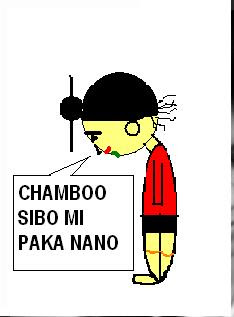 Counting in Tanii is not easy… It may be useful here to sum up the basic features of the Apatani numeral system, although I’m not too sure to understand it fully. Differences are often subtle, and there may exist several ways to express the same number. Moreover, though originally there are only 7 Apatani villages, some dialectal variations occur which can easily lead to confusion. Therefore, as usual, corrections and comments from Tanii readers are welcome...In this post I am only considering numbers when they are used without any reference to an object. In a next post I shall deal with numbers when they are associated with particular objects, animals, humans, etc.
Counting in Tanii is not easy… It may be useful here to sum up the basic features of the Apatani numeral system, although I’m not too sure to understand it fully. Differences are often subtle, and there may exist several ways to express the same number. Moreover, though originally there are only 7 Apatani villages, some dialectal variations occur which can easily lead to confusion. Therefore, as usual, corrections and comments from Tanii readers are welcome...In this post I am only considering numbers when they are used without any reference to an object. In a next post I shall deal with numbers when they are associated with particular objects, animals, humans, etc.
1°) The numeral system is a simple decimal system
The main units are 10 and multiples of 10, 100 and multiples of 100, 1000 and multiples of 1000.
photographer: Christa Neuenhofer
2°) numbers from 1 to 10 are unique forms
1
| ako or kone
|
2
| anye or anyi
|
3
| hinge |
4
| piilye |
5
| yango |
6
| khiiye |
7
| kanu |
8
| pinye |
9
| kowa |
10
| alyan |
3°) Numbers from 11 to 19 are compound words, of the form : ‘ten + unit’.
Units 2, 4, 5 appearing in compound forms are shortened; unique and compound forms for 1 are different; units 3, 6, 7, 8, 9 remain unchanged. The correspondence is given below for the main dialect :
| Appearing in unique form
| Appearing in compound form
|
1
| ako | -kun or -he |
2
| anye/anyi | -nyi |
3
| hin | -hin |
4
| piilye | -pii/-pe/-pyi |
5
| yango | -ngo |
6
| khiiye | -khii |
7
| kanu | -kanu |
8
| pinye/pinyi | -pinye/-pinyi |
9
| kowa | -kowa |
A particle, LE (or HELA), which can be roughly translated as ‘and’, is inserted between ‘ten’ and the unit. The difference between LE and HELA corresponds to 2 ways of counting, which are equivalent :
- ‘ten + HELA + unit (as appearing in unique form)’
- ‘ten + LE + unit (as appearing in compound form)’
Thus 11 is ‘alyan hela ako’ or ‘alyan-le-kung’. Both literally mean "ten and one" and can be used indiscriminately.
| 10 + HELA + unit | 10 + LE + unit |
| 11 | alyan hela ako | alyan le-kun |
12
| alyan hela anye | alyan le-nye/nyi |
13
| alyan hela hinge | alyan le-hin |
14
| alyan hela piilye | alyan le-phe/pi |
15
| alyan hela yango | alyan le-ngo |
16
| alyan hela khiiye | alyan le-khii/khe |
17
| alyan hela kanu | alyan le-kanu |
18
| alyan hela pinye/pinyi | alyan le-pinye/nyi |
19
| alyan hela kowa | alyan le-kowa |
4°) Multiples of ten are compound forms. Compoundings are made either of the form :
- ‘number of tens + KHAN’ : for 20, 30, 70, 80, 90.
- ‘ten + number of tens’ : for 40, 50, 60
Thus :
20
| lyikhan |
30
| hikhan |
40
| alyan-piilye |
50
| alyan-yango |
60
| alyan-khiiye |
70
| kanu-khange |
80
| pinyi-khange |
90
| kowa-khange |
* Note that the prefixes used for 20 and 30 are respectively LYI- and HI-, different from the shortened forms -NYI- and –HING used as suffixes.
* Note also the difference between :
14 (alyan-hela-piilye) and 40 (alyan-piilye)
15 (alyan-hela-yango) and 50 (alyan-yango)
16 (alyan-hela-khiiye) and 60 (alyan-khiiye)
It seems confusing at first sight, but after all no more than English 'fourteen' and 'fourty, 'fifteen' and 'fifty', 'sixteen' and 'sixty'....
5°) multiples of hundred take the form ‘hundred + numeral’, i.e. LANG- + numeral except for 200 and 300 where the compound form of the numeral is prefixed by LA- only. Note also that LANG becomes LAM before the consonant p)
100
| lan(h)e
|
| 200 | lanye/lanyi |
300
| lahin
|
400
| lampii/lampyi
|
500
| lango
|
600
| lankhii
|
700
| lankanu
|
800
| lampinye/lampinyi
|
900
| lankowa
|
6°) Multiples of thousand take the form 'thousand (LALYAN) + numeral' :
lalyan ako = 1000
lalyan anye = 2000
lalyan ahin = 3000
etc.
However in recent years a new compound form including the Hindi word for 'thousand' (JAR) tends to replace it. It takes the form 'thousand (JAR) + numeral (contracted)'1000
| jar(h)e
|
2000
| jarnye/jarnyi
|
3000
| jarhin
|
4000
| jarpii/jarpyi
|
5000
| jarngo
|
6000
| jarkhii
|
7000
| jarkanu
|
8000
| jarpinye/jarpinyi
|
9000
| jarkowa
|
7°) Expressing any number above 10 is made by combining thousands, hundreds, tens and units and separating each category by the particle ‘LA’ (or HELA/LE between tens and units)
Example :
Jarnyi la lahin la alyan hela ako : 2311
P. Bouchery









